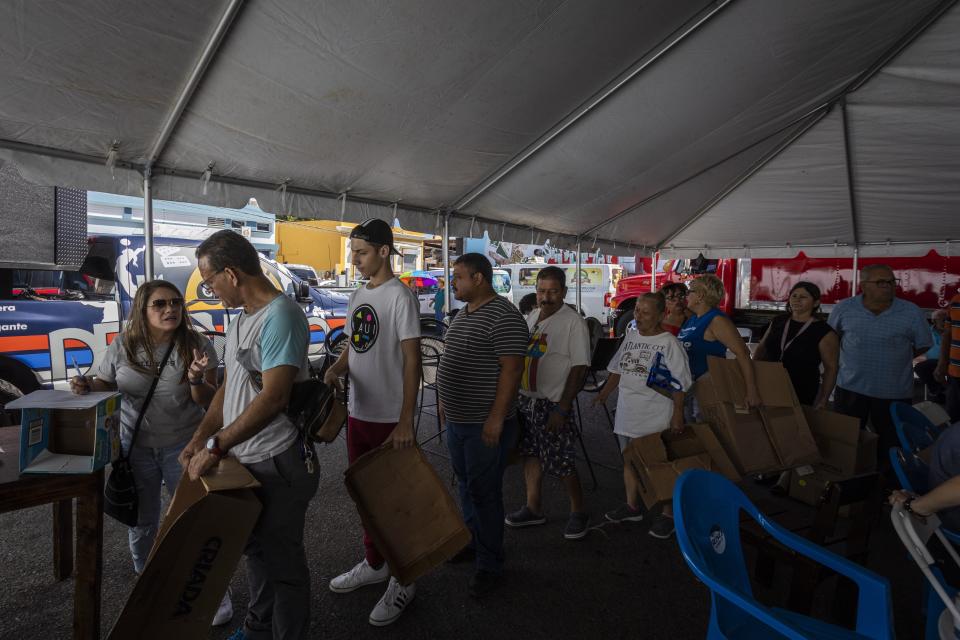Puerto Rico Has Power Back, But Thousands Remain Homeless After Earthquakes
After a recent series of earthquakes hit Puerto Rico, thousands have taken refuge in shelters ― and although power has returned to almost all the island, many are concerned that a drop in tourism could hurt an economy still recovering from Hurricane Maria.
On Saturday, a 5.9-magnitude earthquake caused damage to homes and buildings in the southeastern part of the island ― the same area hit by a powerful 6.4-magnitude quake last week. After an island-wide blackout from the largest quake, power has returned to 99% of the island, officials said Monday.
Yet even with power restored to most of the island, there were nearly 5,000 people staying in government shelters, according to the governor’s office. Others have been sleeping outside of their homes for fear of further tremors. Public schools remain closed as officials carry out safety inspections.
For those living in the hardest-hit area of the south, the repeated quakes have been traumatic.
“I literally saw the wall move. I was petrified, frozen on-site, I couldn’t move. It was just horrible,” said Ely Tanzarite, 70, of last week’s quake, which hit her home in Yauco while she and her husband, Vincent Rosano, were in bed. “Everything came down ― lamps, pictures. It was glass everywhere ― the glass just flew. That was very frightening.”
The next day, the couple left to stay with a friend on the northern side of the island. After Saturday’s quake, they still don’t know whether their house in Yauco is OK. The home was their retirement “dream,” Tanzarite said, on the island where she grew up and where they’ve been spending half the year when they’re not in Rosano’s native Rhode Island.
“The whole thing has shattered the way we feel: You plan you’re gonna spend your retirement in quiet Puerto Rico. And to realize we didn’t feel safe,” Tanzarite said, noting that they’d started sleeping with their clothes and shoes on in case they had to run. Some neighbors have been sleeping in cars, afraid their homes will crumble if another quake hits.


Even for those living beyond the affected area, other concerns abound, including whether tourism will drop again as it did after the deadly Hurricane Maria in 2017, causing monthslong blackouts and leaving towns that rely on visitors devastated.
“The PTSD from facing being closed again after Maria may be more than we can bear,” said Lisa Masters, the owner of the boutique hotel Tres Sirenas in Rincón, on the western tip of the island. While her place has been physically unaffected by the quakes ― power came back a day after the islandwide blackout last week ― she’s felt the financial consequences as guests call to cancel reservations. She’s had to temporarily lay off her staff.
“The potential economic crisis that will ensue [from] the quakes disrupting tourism will be far greater than the damage done by the quake itself,” Masters warned, urging visitors to come to the island.
Discover Puerto Rico, the island’s destination marketing organization launched in 2018 by former Gov. Ricardo Rossello’s administration, is encouraging all visitors with upcoming trips to the island to “continue to show their support for the Island as tourism is vital to keep the economy recovering.”
“Puerto Rico is open for tourism,” said Brad Dean, CEO of Discover Puerto Rico, noting that power is restored in almost all parts of the island and that airports and major hotels are all running as usual. “We must keep tourism strong as it fuels local communities.”
After calls from lawmakers, President Donald Trump signed an emergency declaration for Puerto Rico last week, allowing federal assistance to go to the island in response to the quakes. The Federal Emergency Management Agency said Puerto Rico’s request for a major disaster declaration — which would allow for more federal aid — was “currently under review.”
California Gov. Gavin Newsom (D) sent over two dozen disaster specialists to the island for two weeks to help with emergency management, safety assessments and more.
However, Sen. Bernie Sanders (I-Vt.) and Reps. Nydia Velázquez (D-N.Y.) and Alexandria Ocasio-Cortez (D-N.Y.) sent a letter to Trump on Monday demanding that his administration release the $18 billion in federal disaster assistance that Congress approved post-Maria and that Puerto Rico is still waiting on.
A spokesperson for the White House Office of Management and Budget told HuffPost that the Trump administration “has been working to support recovery efforts in Puerto Rico” and that over $90 billion “has been forecast” to go to the island’s recovery efforts.
This story has been updated with responses from FEMA and the White House.
Related...
When The Tourists Stopped Coming, This Puerto Rican Town's Nightmare Began
Trump Signs Emergency Declaration For Puerto Rico After Earthquakes
Magnitude 5.9 Shock Rocks Quake-Stunned Puerto Rico
Love HuffPost? Become a founding member of HuffPost Plus today.
This article originally appeared on HuffPost.

